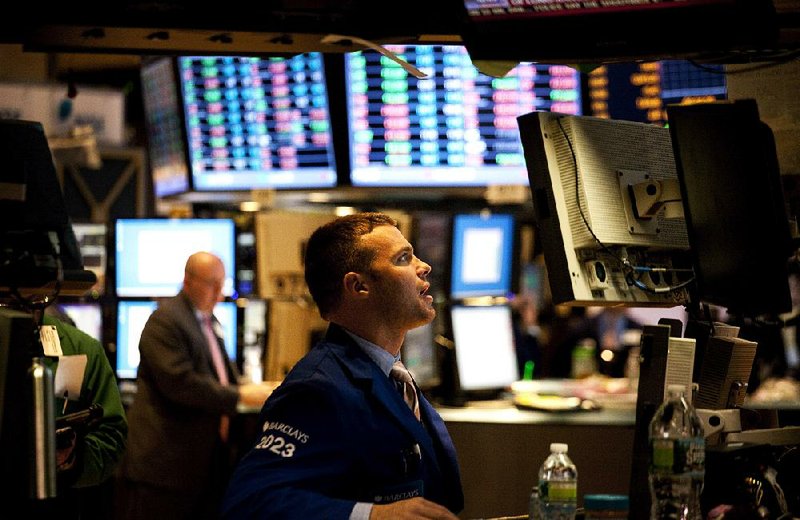NEW YORK — The stock market extended its longest and deepest slump of the year Tuesday, caught between recurring worries about European debt and the beginning of uncertain corporate earnings reports at home.
The Dow Jones industrial average fell 213.66 points, its biggest decline of the year and third triple-digit loss in four days. It closed at 12,715.93, its lowest since Feb. 2.
A five-day losing streak has shaved about 550 points off the Dow, about half what it gained from January through March.
In Europe, concern about the financial health of Spain intensified, and borrowing costs for Spain and Italy rose considerably. Spain’s borrowing costs crept closer to levels that have forced other countries to seek bailouts.
European markets sold off while Wall Street was still sleeping. The main stock indexes in Spain and France closed down about 3 percent, the equivalent of a 400-point drop in the Dow.
“They’ve managed to put a Band-Aid on the debt crisis, but there’s really no solution,” said Colleen Supran, a principal at the investment adviser Bingham, Osborn & Scarborough. “And Spain is a much bigger problem than Greece.”
The yield on 10-year Spanish bonds rose to almost 6 percent. The point at which governments can no longer afford to raise money on the international bond markets and must seek bailouts is generally considered to be 7 percent.
The 7 percent level forced Greece, the last focal point of the European debt crisis, to seek rescue loans. But Spain’s economy is more than five times as large as Greece’s.
Jeffrey Cleveland, senior economist at Payden & Rygel in Los Angeles, compared the financial markets to a person coming off a sugar high — in this case, the bailout package for Greece put together late last year.
“It works for a few minutes, but eventually reality reasserts itself,” Cleveland said. “Nothing has been solved in Europe. People are paying attention to it now. They were able to ignore it for a little while.”
In the United States, stock in Alcoa, the aluminum company, surged 5.3 percent after the market closed. Minutes after the closing bell, the company reported profit of 9 cents per share. Analysts had expected a loss of 4 cents.
Alcoa was the first of the 30 stocks in the Dow to report its quarterly results, and earnings will help determine whether the market continues its slide or reverses it.
After nine consecutive quarters of earnings growth, analysts think earnings will be flat this time. Those predictions came before Alcoa’s impressive results, however.
“Whatever qualif ications you want to give it — it’s because of cost-cutting, they’ve laid off a lot of people — earnings have been one bright spot,” said Adrian Day, president of Adrian Day Asset Management in Annapolis, Md. “If that were to turn, that would be sort of the last leg on the stool being knocked away.”
The first three months of this year were the best for stocks since 1998, but investors have found plenty to fret about in April.
The losing streak began last Tuesday, when the Federal Reserve said it was worried about the strength of job growth and suggested it was not inclined to provide further help for the economy.
The Dow fell 204 points in three days. It fell 131 more Monday, the first time investors could react to a report showing much weaker job growth in March than in the three previous months.
Then, on Tuesday, the National Federation of Independent Business reported a drop in its small-business optimism index, the first decline after six months of gains.
That report helped knock stocks down at the open, and with Europe to worry about, they sank all day. The S&P finished down 23.61 points, its worst one-day decline this year, at 1,358.59.
The Nasdaq composite index, which eked out a gain in one of the past four days, ended down 55.86 points, its worst performance this year, at 2,991.22. It closed below 3,000 for the first time in a month.
The Dow’s 8 percent gain through the first quarter has been shaved to 4 percent. The S&P’s gain of 12 percent has been cut to 8 percent. And the Nasdaq’s run of almost 20 percent is now just 15.
Last year, the Dow’s longest losing streak was an eight-day, 858-point plunge in July and August, with Congress bickering over the government debt limit and just before the S&P ratings agency downgraded the U.S.
The worst-performing stock in the Dow was Bank of America, which tends to take a hit when concerns about Europe grow stronger. Bank of America was down 4.4 percent.
The ratio of declining stocks to advancing stocks was about 5-to-1 and consolidated volume on the New York Stock Exchange was a heavy 4.6 billion shares.
One big factor in the selloff is fear that growth is slowing in the world’s biggest economies. Recent economic reports from the United States and China have come in far below investors’ expectations.
Investors are pricing in slower growth in the United States, said Neil Dutta, an economist at Bank of America Merrill Lynch. He predicts the S&P will end the year at about 1,400, only about 3 percent higher than where it finished Tuesday.
For now, he said, “the likelihood is that the sell-off is probably not done.”
Information for this article was contributed by Christopher S. Rugaber of The Associated Press.
Business, Pages 23 on 04/11/2012
